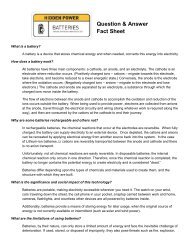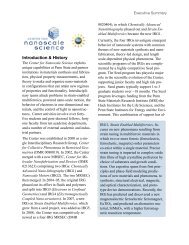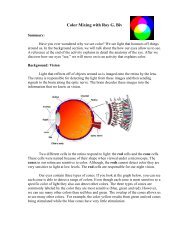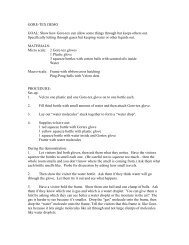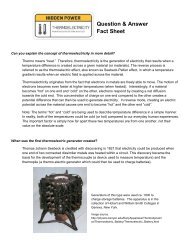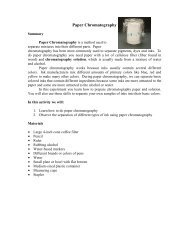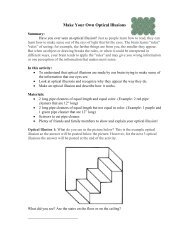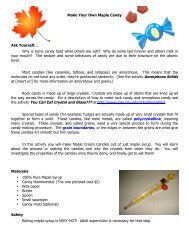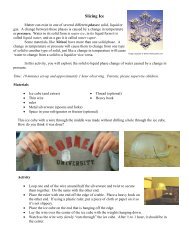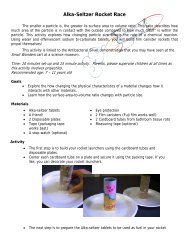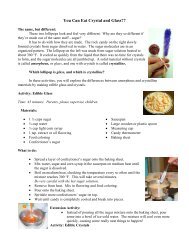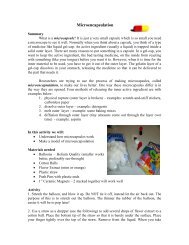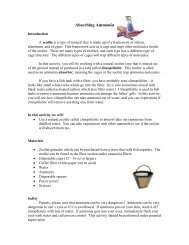Amorphous Solids Ask Yourself⦠Can you picture the atoms that ...
Amorphous Solids Ask Yourself⦠Can you picture the atoms that ...
Amorphous Solids Ask Yourself⦠Can you picture the atoms that ...
Create successful ePaper yourself
Turn your PDF publications into a flip-book with our unique Google optimized e-Paper software.
In this experiment, <strong>you</strong> will make a large-scale model of <strong>the</strong> <strong>atoms</strong> of a single grain, and <strong>the</strong>n<br />
an amorphous solid. Finally, <strong>you</strong> will model a grain boundary between two grains.<br />
Materials<br />
• Large kitchen bowl<br />
• Two sizes of round candies*<br />
• Shoe box<br />
*<strong>Can</strong>dies should be different in size, but<br />
larger candy should be no more than 3 times<br />
larger than <strong>the</strong> small candy. Both types of<br />
candy should be perfectly round.<br />
Gobbstoppers (for <strong>the</strong> smaller) and<br />
Whoppers (for <strong>the</strong> larger) work well. If <strong>you</strong><br />
have <strong>the</strong>m, marbles and BBs work well.<br />
Safety<br />
Caution should be taken when shaking <strong>the</strong> model.<br />
Activity<br />
First, <strong>you</strong> will make a large-scale model of a crystalline solid. To begin, pour enough of <strong>the</strong><br />
smaller candy into <strong>the</strong> bowl to cover <strong>the</strong> bottom with one layer<br />
of candy. Each candy represents one atom. Gently shake <strong>the</strong><br />
bowl from side to side and watch how <strong>the</strong> “<strong>atoms</strong>” move. Keep<br />
shaking until all of <strong>the</strong> <strong>atoms</strong> line up in straight lines, as seen in<br />
<strong>the</strong> <strong>picture</strong> to <strong>the</strong> right.<br />
What do <strong>you</strong> notice? How many directions of ordering<br />
can <strong>you</strong> find? Do any of <strong>the</strong> rows of <strong>atoms</strong> go all <strong>the</strong> way from<br />
one side to <strong>the</strong> o<strong>the</strong>r? What happens at <strong>the</strong> edges? Write<br />
down <strong>you</strong>r observations.<br />
This is a large-scale model of a single grain. Notice <strong>that</strong> this model has long-range order<br />
because <strong>the</strong> rows of <strong>atoms</strong> continue across <strong>the</strong> grain. This is how <strong>the</strong> <strong>atoms</strong> are arranged in a grain<br />
of typical metals. Is this how <strong>you</strong> <strong>picture</strong>d <strong>the</strong> <strong>atoms</strong> in <strong>you</strong>r spoon? Your fork?<br />
Next, <strong>you</strong> will make a large-scale model of <strong>the</strong> <strong>atoms</strong> in an amorphous solid. Take <strong>the</strong> bowl<br />
with <strong>the</strong> small <strong>atoms</strong>, and add <strong>the</strong> bigger <strong>atoms</strong> (<strong>the</strong> larger size candy). You do not need as many of<br />
<strong>the</strong> bigger <strong>atoms</strong>, estimate one fourth to one third <strong>the</strong> number of small <strong>atoms</strong>. Mix <strong>the</strong> <strong>atoms</strong> up<br />
with <strong>you</strong>r hands until all <strong>the</strong> big <strong>atoms</strong> have been distributed. Again, gently shake <strong>the</strong> mixture back<br />
and fourth and watch what happens to <strong>the</strong> <strong>atoms</strong>. They should start to look something like <strong>the</strong><br />
<strong>picture</strong> on <strong>the</strong> right.



